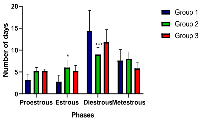The effects of variations in length of suction pipette inserted during vaginal smear cytology procedure on estrous cycle in Sprague–Dawley rats
Main Article Content
Abstract
Estrous cycle is a periodic reproductive sequence of events in most female laboratory animals that are used for basic research. Several methods have been used to stage estrous cycle, these include visual method, vagina smear cytology evaluation, chemical analysis of urine and the analysis of electrical resistance. The vaginal smear cytology (VSC) evaluation method is commonly used to stage estrous cycle because it is a faster method coupled with easy execution and not as expensive as the other methods. The study of estrous cycle is primary to all investigations in reproduction and related areas. For the generation of dependable research outcome from VSC evaluation method, the technique for the collection of vagina smear and its microscopic interpretation must be done according to established standards. Many reports in literature concerning VSC evaluation method, lack comprehensive demonstrations and uniformity which lead to loss of homogeneity and hence provide study outcomes that are not authentic. Therefore, t his present investigation was designed to establish the standard value of inserted length of suction pipette during smear extraction technique when using VSC method to study estrous cycle. A total of fifteen experimental animals were recruited for this investigation. The animals were subdivided into three groups 1 to 3. The lengths of pipette inserted into the vagina canal were varied from 1mm, 2mm to 4mm in group 1, 2 and 3 respectively. The outcome from this investigation showed that the depth of suction pipette inserted during smear extraction procedure in VSC method has effect on estrous cycling. Estrous cycle was maintained with 2mm insertion length with approximate four days cycle and phases changing daily.
Downloads
Article Details

This work is licensed under a Creative Commons Attribution-NonCommercial-NoDerivatives 4.0 International License.
References
American Physiological Society. (2002). Guiding principles for research involving animals and human beings. American Journal of Physiology-Regulatory, Integrative and Comparative Physiology 283: 281 – 283.
Ayodeji, F. and Roland, E. (2020). Staging of the estrous cycle and induction of estrus in experimental rodents: An update. Fertility Research and Practice 6(1):5.
Bakare, A. A., Abdulkareem, O. T., Falana, B. A., Adeleke, O. S. (2021). Assessment of vaginal smear cytology procedure in Southwestern Nigeria institutions. Journal of Experimental Research 9 (3): 2502-0524.
Caligioni, C. (2009). Assessing reproductive status/stages in mice. Current Protocol Neuroscience 4: 1-6.
Eder, Z., Margaritis, V., Tanja, Z., Joel, T., Jamie, J., Xiao, F., John, R., Stafford, L., Kevin, O. and Krasimira, T. (2020). Dynamic hormone control of stress and fertility. Frontiers in Physiology 11:598845 doi.org/10.3389/fphys.2020.598845.
Geoffrey, A. W. , Jimmie, E. F., Katrina, L. M., Watson, R. K. (2007). Circulating hormones and estrous stage predict cellular and stromal remodeling in murine uterus. Journal for society of reproduction and fertility133(5):1035-44.
Gnanagurudasan, E., Senthil, K. S. K., Leena, D. J. (2017). Comparative Study on the Estimation of estrous cycle in mice by visual and vaginal lavage method. Journal of Clinical and Diagnostic Research11(1):5-7.
Hubscher, C. H., Brooks, D. L., and Johnson, J. R. (2005). A quantitative method for assessing stages of the rat estrous cycle. Biotechnic & Histochemistry 80:79–87.
Long, J. A., and Evans, H. M. (1922). The oestrous cycle in the rat and its associated phenomena. Mem University of Califonia6:1–148.
Kaneko, T., Endo, M. and Tsunoda, S. (2020). Simple induction of pseudopregnancy by artificial stimulation using a sonic vibration in rats. Science Report 10: 2729.
Marcondes, F. K., Bianchi, F. J. and Tanno, A. P.(2002). Determination of the estrous cycle phases of rats: Some helpful considerations. Brazilian Journal of Biology, 62(4a): 609-14.
Mccracken, J. A., Custer, E. E., Lamsa, J. C. (1999). Luteolysis: A neuroendocrine-mediated event. Physiological Reviews 79 (2): 263–323.
Michelle, C. C., Linda, k., Greg, T. (2015). Vaginal cytology of the laboratory rat and mouse: review and criteria for the staging of the
estrous cycle using stained vaginal smear. Toxicologic pathology 20: 1-18.
Robert, H., Ferguson, L., Reins, O., Greco, T., Prins, M. L., Folkerts, M. (2021). Rodent estrous cycle monitoring utilizing vaginal lavage: no
such thing as a normal cycle. Journal of Visualized Experiments 174:62884.
Shannon, L. B., Michael, V. W., Sadie, L. D. and Robert, A. T. (2012). Mouse estrous cycle identification tool and images. PLoS One 7(4): e35538.
Spornitz, U. M., Socin, C. D. And David, A. A. (1999). Estrous stage determination in rats by means of scanning electron microscopic
images of uterine surface epithelium.Anatomical Record 254: 116-126.
Trishala, C., Sophie, G., Nick, A. A., and Michela, F.(2020). The stage of the estrus cycle is critical for interpretation of female mouse social interaction behavior. Frontiers in Behavioral Neuroscience 14:113 doi: 10.3389/fnbeh.2020.00113.


